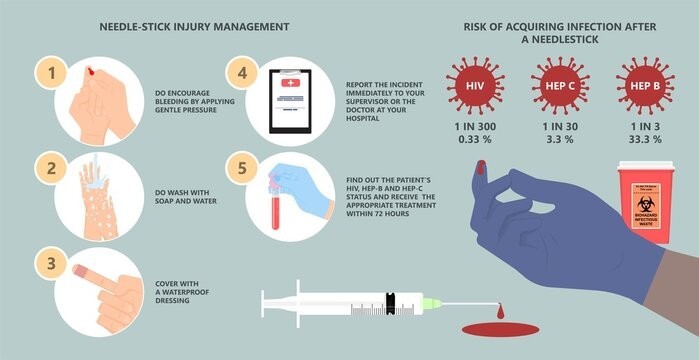A nurse administered an IM injection to a client. Which of the following actions should the nurse take to reduce the risk of a needlestick injury?
Place a cap holder securely on the used needle before disposal
Recap the needle for disposal later.
Dispose of the used needle immediately in a sharps container.
Detach the used needle and dispose of it promptly.
The Correct Answer is C
c. Dispose of the used needle immediately in a sharps container.
The nurse should dispose of the used needle immediately in a sharps container to reduce the risk of a needlestick injury. Sharps containers are specifically designed for the safe disposal of needles and other sharp objects. By placing the used needle directly into a sharps container, the nurse eliminates the need for handling or manipulating the needle further, reducing the risk of accidental needlestick injuries.
Explanation for the other options:
a. Place a cap holder securely on the used needle before disposal: Cap holders are not recommended for securing used needles before disposal. They may not provide adequate protection against needlestick injuries and can potentially increase the risk of accidental needlesticks when atempting to secure the cap holder.
b. Recap the needle for disposal later: Recapping the needle increases the risk of a needlestick injury. It is generally not recommended to recap needles after use, as it poses a greater risk of accidental puncture.
d. Detach the used needle and dispose of it promptly: Detaching the needle from the syringe before disposal is not recommended, as it increases the risk of a needlestick injury. It is safer to dispose of the needle and syringe as a unit in a sharps container to minimize the risk of accidental puncture.

Nursing Test Bank
Naxlex Comprehensive Predictor Exams
Related Questions
Correct Answer is B
Explanation
The correct answer is b. "I will apply petroleum jelly to the penis with each diaper change."
Choice A rationale:
- It is incorrect to focus on removing all yellow exudate.A small amount of yellow exudate is normal during the healing process after circumcision.Attempting to aggressively clean it off can irritate the delicate healing tissues and cause discomfort for the baby.
- Instead,parents should gently cleanse the area with warm water during diaper changes,allowing any mild exudate to naturally drain.
Choice B rationale:
- Applying petroleum jelly with each diaper change is an essential step in promoting healing and preventing discomfort after circumcision.Here's why:
- Protects against moisture:Petroleum jelly forms a barrier that protects the delicate healing tissues from moisture from urine and feces.This helps to prevent irritation and keeps the area clean.
- Reduces friction:The lubricating properties of petroleum jelly reduce friction between the penis and the diaper,which can minimize discomfort and pain for the baby.
- Promotes healing:Petroleum jelly creates a moist environment that promotes healing and reduces scab formation.This helps the circumcision site to heal faster and more comfortably.
Choice C rationale:
- While ensuring a proper diaper fit is important for overall hygiene,it's not the most crucial aspect of post-circumcision care.A snug diaper can put unnecessary pressure on the healing penis,potentially causing irritation and discomfort.It's generally recommended to choose a diaper that fits comfortably without being too tight.
Choice D rationale:
- Using soap to wash the penis is not recommended during the healing process.Soap can be harsh and drying to the delicate tissues,potentially causing irritation and delaying healing.
- Warm water is sufficient for cleansing the area during diaper changes.

Correct Answer is C
Explanation
Restlessness is a common sign that a client's pain is not adequately relieved. When a client experience unrelieved pain, they may find it difficult to get comfortable and may exhibit restlessness, such as frequently changing positions, fidgeting, or appearing agitated. It is important for the nurse to assess the client's pain level and address any concerns regarding pain management.
While difficulty swallowing (dysphagia), constipation, and urinary retention can be potential side effects or complications associated with spinal epidural anesthesia, they are not specific indicators of unrelieved pain. These findings may be related to the effects of the anesthesia itself or other factors, and they should still be assessed and addressed by the nurse. However, restlessness is more directly linked to the experience of pain and should be recognized as an important sign that the client's pain relief measures may need adjustment.

Whether you are a student looking to ace your exams or a practicing nurse seeking to enhance your expertise , our nursing education contents will empower you with the confidence and competence to make a difference in the lives of patients and become a respected leader in the healthcare field.
Visit Naxlex, invest in your future and unlock endless possibilities with our unparalleled nursing education contents today
Report Wrong Answer on the Current Question
Do you disagree with the answer? If yes, what is your expected answer? Explain.
Kindly be descriptive with the issue you are facing.
